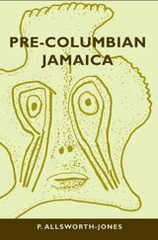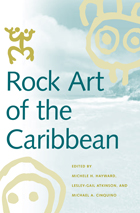2 books by Allsworth-Jones, Phillip

Pre-Columbian Jamaica
Phillip Allsworth-Jones
University of Alabama Press, 2008
Much of Jamaican prehistoric research—like that in the rest of the Caribbean basin—has been guided by at least a subconscious attempt to allow prehistoric native peoples to find their places within the charts established by Irving Rouse, who guided Caribbean research for much of the last half-century. The pre-Columbian peoples of Jamaica, and not merely their material culture, are beginning to take form, revealing their lifestyles and rituals, and taking their rightful place among the cultures of the New World.
Pre-Columbian Jamaica represents the first substantial attempt to summarize the prehistoric evidence from the island in a single published account since J. E. Duerden’s invaluable 1897 article on the subject, which is also reprinted within this volume. The book is designed to provide general commentary that can stand alone and be read as a continuous narrative; and as an additional and valuable resource is the accompanying CD-ROM that furnishes a great range of further illustrations, data, calculations, measurements, and comparisons. This data is curated at the Archaeology Laboratory at the University of the West Indies, Mona Campus, in Kingston, and was presented to the university by Dr. James Lee in 2000. His gift, and the comprehensive study that followed, provide the impetus for both the book and the CD-ROM.
[more]

Rock Art of the Caribbean
Edited by Michele Hayward, Lesley-Gail Atkinson, and Michael A. Cinquino
University of Alabama Press, 2009
This compilation, by an international grouping of scholars, focuses on the nature of Caribbean rock art or rock graphics and makes clear the region's substantial and distinctive rock art tradition. Thorough and comparative, it includes data on the history of rock graphic research, the nature of the assemblages (image numbers, types, locations), and the legal, conservation, and research status of the image sites. Chapters on these topics cover research on the islands of Cuba, Haiti, Dominican Republic, the Bahamas, Jamaica, Puerto Rico, U.S. Virgin Islands, Guadeloupe, Aruba, and Bonaire. The prehispanic rock art and other ceremonial structures and artifacts, along with enthnohistorical accounts of the region at Contact, projected backward in time, all point to an active ritual and ceremonial life involving commoners, religious specialists, and elites in differing and interconnected roles and for diverse purposes. The selective use of common rock graphic design and physical elements can be seen in the distribution and execution of the carved and painted images. Pecked, ground, abraded, and scratched petroglyphs, along with pictographs done frequently in red, black, white and orange hues are found on a range of rock surfaces including limestones, granites, diorites, and andesites. Caves/rock shelters and rock formations associated with water sources (water ways, pools, ocean) account for the two most common locations, followed by ball court sites, inland rock outcroppings and beach rock.
In addition to specific area presentations, the work includes a review of recent advances in Caribbean rock graphic studies including dating and interpretative models; the application of a new documentation method and resulting computer manipulation advantages; a conservation project in Jamaica that has implications for the preservation and interpretation of the site; and a proposed dating sequence for the Lesser Antillean
Windward Islands.
[more]
READERS
Browse our collection.
PUBLISHERS
See BiblioVault's publisher services.
STUDENT SERVICES
Files for college accessibility offices.
UChicago Accessibility Resources
home | accessibility | search | about | contact us
BiblioVault ® 2001 - 2024
The University of Chicago Press









